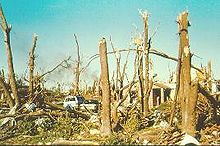Note: Tornadoes are very dangerous and potentially deadly. Always take tornado warnings seriously and immediately seek shelter. |
The Tornadoes Portal

Selected tornado article -
Selected tornado list -
This page documents all tornadoes confirmed by various weather forecast offices of the National Weather Service in the United States from January to March 2018. Based on the 1991–2010 average, 35 tornadoes touch down in January, 29 touch down in February and 80 touch down in March. These tornadoes are commonly focused across the Southern United States due to their proximity to the unstable airmass and warm waters of the Gulf of Mexico, as well as California in association with winter storms.
A small late-January outbreak produced over a dozen tornadoes, but the month was otherwise quiet and finished below average with 15 tornadoes. A larger and more significant outbreak occurred in late-February, which pushed the month well above average with 51 tornadoes. A few sizeable outbreaks also occurred in March, but the month was still well below average with only 55 tornadoes. (Full article...)Selected image -

Selected tornado year -
Related portals
2024 tornado activity

List of 2024 tornado articles
|
|---|
Tornado anniversaries
July 1
- 1873 – An F4 tornado hit Erie and Shilo Township, Kansas, killing five people. An eyewitness stated "the night phantom appeared to be composed of fire."
- 1877 – A tornado outbreak hit the Northeastern United States. A slow-moving F4 tornado struck Parkesburg and Ercildoun, Pennsylvania, killing two people and injuring 25. Debris was carried 9 miles (14 km).
July 2
- 1879 – A significant tornado outbreak hit the Upper Midwest. An F4 tornado killed 11 people near Vasa, Minnesota, including five children at an orphanage. Some of the survivors were not found until the next day. Another F4 tornado killed three people between Wastedo and Cannon Falls, Minnesota and two others died near Le Mars, Iowa.
- 1997 – Part of a larger outbreak, an F2 tornado moved through Detroit, Michigan, injuring 90 people and causing $100 million in damage. An F3 tornado killed one person in Thetford Township, Michigan and an F1 tornado killed a person in a trailer park in Oakland County, Michigan.
July 3
- 1947 – A tornado family, killed one person near Windygates, Manitoba, and seven others on a beet farm near Auburn, North Dakota. An F4 tornado killed three people as it destroyed homes near Warsaw, North Dakota and Oslo, Minnesota.
Did you know…
- ...that the 2013 Moore tornado that struck Moore and Newcastle, Oklahoma, is the most recent EF5 tornado?
- ...that the 2021 South Moravia tornado, an IF4 tornado with winds between 207–260 mph (333–418 km/h), was the strongest tornado to hit the Czech Republic in modern history?
General images -

From May 2 to 8, 1999, a large tornado outbreak took place across much of the Central and parts of the Eastern United States, as well as southern Canada. During this week-long event, 152 tornadoes touched down in these areas. The most dramatic events unfolded during the afternoon of May 3 through the early morning hours of May 4 when more than half of these storms occurred. Oklahoma experienced its largest tornado outbreak on record, with 70 confirmed. The most notable of these was the F5 Bridge Creek–Moore tornado which devastated Oklahoma City and suburban communities. The tornado killed 36 people and injured 583 others; losses amounted to $1 billion, making it the first billion-dollar tornado in history. Overall, 50 people lost their lives during the outbreak and damage amounted to $1.4 billion.
On May 2, a strong area of low pressure moved out of the Rocky Mountains and into the High Plains, producing scattered severe weather and ten tornadoes in Nebraska. The following day, atmospheric conditions across Oklahoma became significantly more favorable for an outbreak of severe weather. Wind profiles across the region strongly favored tornadic activity, with the Storm Prediction Center stating, "it became more obvious something major was looming" by the afternoon hours. Numerous supercell thunderstorms developed across the state as well as bordering areas in Kansas and Texas. Over the following 48 hours, May 3–4, 116 tornadoes touched down across the Central United States. Following the extensive outbreak, activity became increasingly scattered from May 5 to 8, with 26 tornadoes touching down across the Eastern United States and Quebec.
(Full article...)List of Featured articles and lists
|
|---|
Topics
Subcategories
Related WikiProjects
The scope of WikiProject Severe weather is to write articles about severe weather, namely thunderstorms and tornadoes. Their talk page is located here.
WikiProject Weather is the main hub for all articles that are weather-related. WikiProject Weather strives to improve articles in a variety of weather topics, including Tropical Cyclones, Severe Weather, General meteorology, Non-tropical Storms, Climate, Floods, Droughts and wildfires, Meteorological instruments and data, Meteorological Biographies, and Space Weather. If you would like to help, please visit the project talk page.
WikiProject Meteorology is a collaborative effort by dozens of Wikipedians to improve the quality of meteorology- and weather-related articles. If you would like to help, visit the project talk page, and see what needs doing. The project is currently being merged into WikiProject Weather.
WikiProject Tropical cyclones is a daughter project of WikiProject meteorology. The dozens of semi-active members and several full-time members focus on improving Wikipedia's coverage of tropical cyclones.
Wikipedia is a fully collaborative effort by volunteers. So if you see something you think you can improve, be bold and get to editing! We appreciate any help you can provide!
Things you can do
Wikimedia
The following Wikimedia Foundation sister projects provide more on this subject:
-
Commons
Free media repository -
Wikibooks
Free textbooks and manuals -
Wikidata
Free knowledge base -
Wikinews
Free-content news -
Wikiquote
Collection of quotations -
Wikisource
Free-content library -
Wikiversity
Free learning tools -
Wikivoyage
Free travel guide -
Wiktionary
Dictionary and thesaurus






































